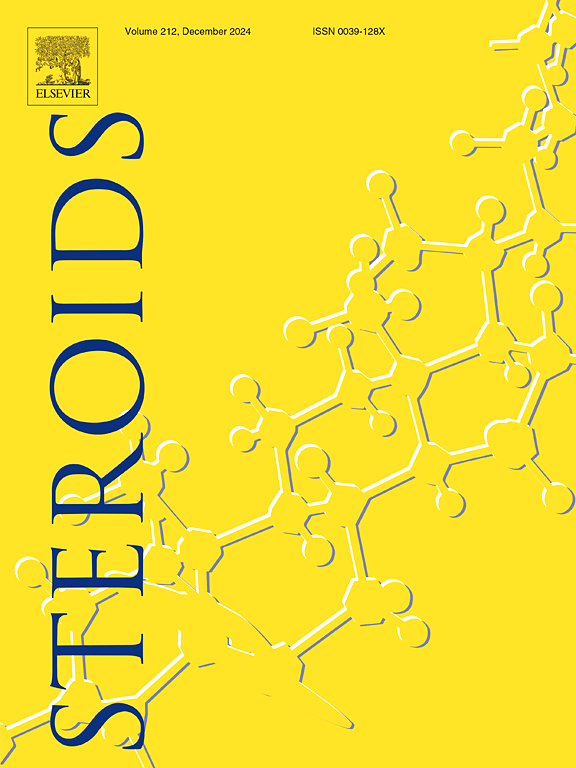Design and discovery of novel heteroaryl substituted pregnenolone derivatives as potent anti-neuroinflammatory agents targeting LPS-stimulated BV-2 microglial cells
IF 2.1
4区 医学
Q4 BIOCHEMISTRY & MOLECULAR BIOLOGY
引用次数: 0
Abstract
A new family of steroidal compounds based on a heteroaryl-4,5-dihydropyrazole thiazolinone core structure was designed and synthesized through structural modifications. The anti-neuroinflammatory activity of these compounds was evaluated in lipopolysaccharide (LPS)-stimulated murine microglial BV-2 cells in vitro. Among the synthesized compounds, 10b and 10d effectively inhibited nitric oxide (NO) production, with compound 10b emerging as the most potent anti-neuroinflammatory agent (IC50 = 2.05 μM). Compound 10b demonstrated significantly greater inhibitory effects than progesterone (prog) (IC50 = 3.23 μM) and reduced NO production in a concentration-dependent manner. Furthermore, compound 10b attenuated the release of pro-inflammatory mediators, including tumour necrosis factor (TNF)-α, interleukin-1β (IL-1β), interleukin-6 (IL-6), and prostaglandin E2 (PGE2). It also inhibited the expression of inducible nitric oxide synthase (iNOS) and cyclooxygenase-2 (COX-2). Mechanistic studies revealed that compound 10b significantly suppressed the transcriptional activity of nuclear factor kappa B (NF-κB) in activated microglial cells and prevented NF-κB p65 activation and IκBα degradation. These effects were likely mediated by the inhibition of c-Jun N-terminal kinase (JNK) and extracellular signal-regulated kinase (ERK) signaling pathways. Additionally, molecular docking studies suggested that the anti-neuroinflammatory effects of compound 10b may result from its hydrophobic and hydrophilic interactions with iNOS and COX-2, supporting its proposed mechanism of action. In summary, these findings suggest that compound 10b exerts anti-neuroinflammatory effects in LPS-stimulated BV-2 microglial cells by modulating key inflammatory pathways, including NF-κB and MAPK signaling.

设计和发现新的杂芳基取代孕烯醇酮衍生物,作为有效的抗神经炎药物,靶向lps刺激的BV-2小胶质细胞
以杂芳基-4,5-二氢吡唑噻唑啉酮为核心结构,通过结构修饰,设计合成了一类新的甾体化合物。这些化合物的抗神经炎活性在体外脂多糖(LPS)刺激的小鼠小胶质BV-2细胞中进行了评估。在所合成的化合物中,化合物10b和10d能有效抑制一氧化氮(NO)的产生,其中化合物10b的抗神经炎作用最强(IC50 = 2.05 μM)。化合物10b的抑制作用显著高于孕酮prog (IC50 = 3.23 μM),并呈浓度依赖性地降低NO的生成。此外,化合物10b减少了促炎介质的释放,包括肿瘤坏死因子(TNF)-α、白细胞介素-1β (IL-1β)、白细胞介素-6 (IL-6)和前列腺素E2 (PGE2)。对诱导型一氧化氮合酶(iNOS)和环氧合酶-2 (COX-2)的表达也有抑制作用。机制研究表明,化合物10b可显著抑制活化小胶质细胞中核因子κB (NF-κB)的转录活性,抑制NF-κB p65的活化和i -κB α的降解。这些作用可能是通过抑制c-Jun n末端激酶(JNK)和细胞外信号调节激酶(ERK)信号通路介导的。此外,分子对接研究表明,化合物10b的抗神经炎症作用可能是由其与iNOS和COX-2的疏水和亲水相互作用引起的,支持了其作用机制。综上所述,这些发现表明化合物10b通过调节包括NF-κB和MAPK信号在内的关键炎症通路,在lps刺激的BV-2小胶质细胞中发挥抗神经炎症作用。
本文章由计算机程序翻译,如有差异,请以英文原文为准。
求助全文
约1分钟内获得全文
求助全文
来源期刊

Steroids
医学-内分泌学与代谢
CiteScore
5.10
自引率
3.70%
发文量
120
审稿时长
73 days
期刊介绍:
STEROIDS is an international research journal devoted to studies on all chemical and biological aspects of steroidal moieties. The journal focuses on both experimental and theoretical studies on the biology, chemistry, biosynthesis, metabolism, molecular biology, physiology and pharmacology of steroids and other molecules that target or regulate steroid receptors. Manuscripts presenting clinical research related to steroids, steroid drug development, comparative endocrinology of steroid hormones, investigations on the mechanism of steroid action and steroid chemistry are all appropriate for submission for peer review. STEROIDS publishes both original research and timely reviews. For details concerning the preparation of manuscripts see Instructions to Authors, which is published in each issue of the journal.
 求助内容:
求助内容: 应助结果提醒方式:
应助结果提醒方式:


